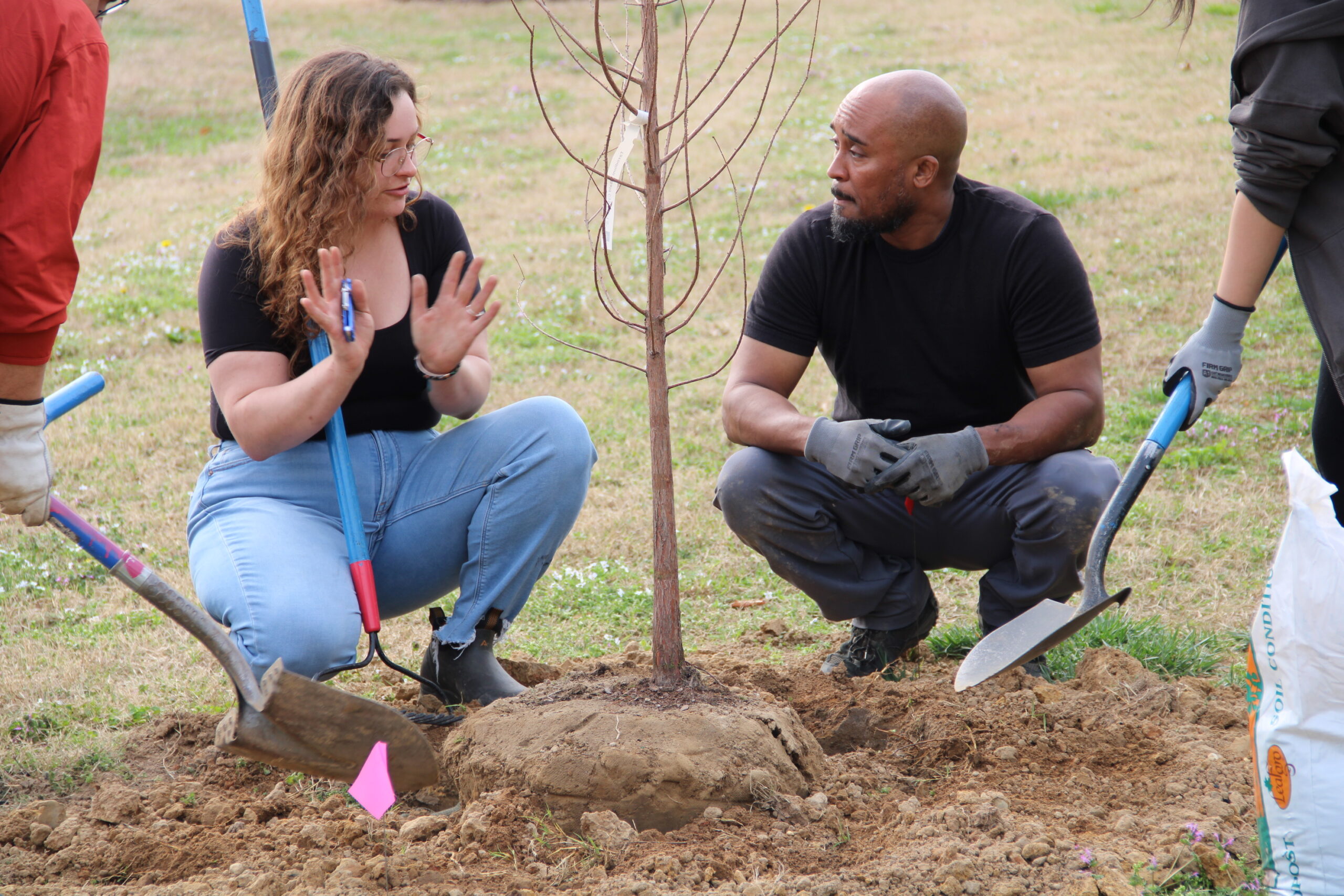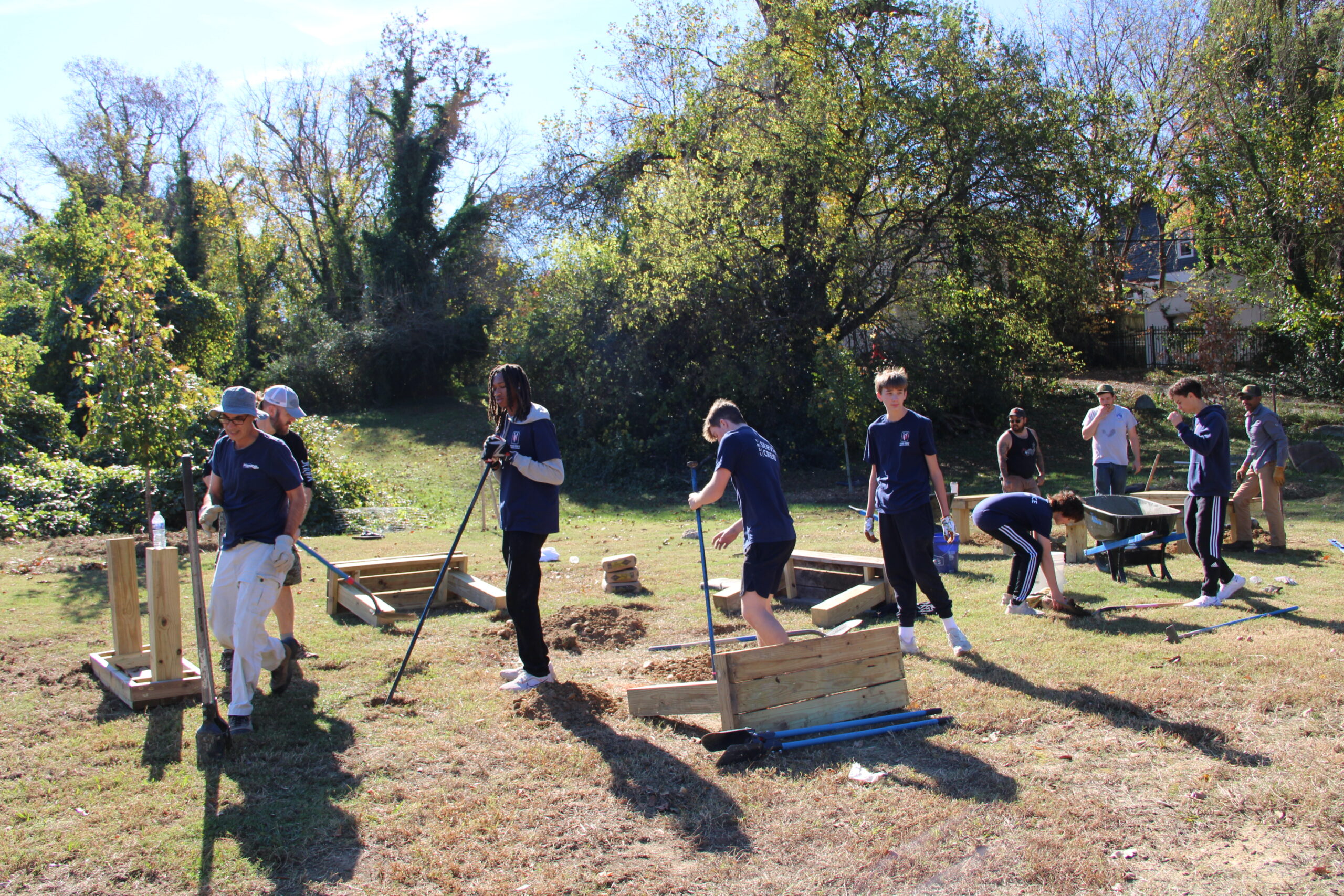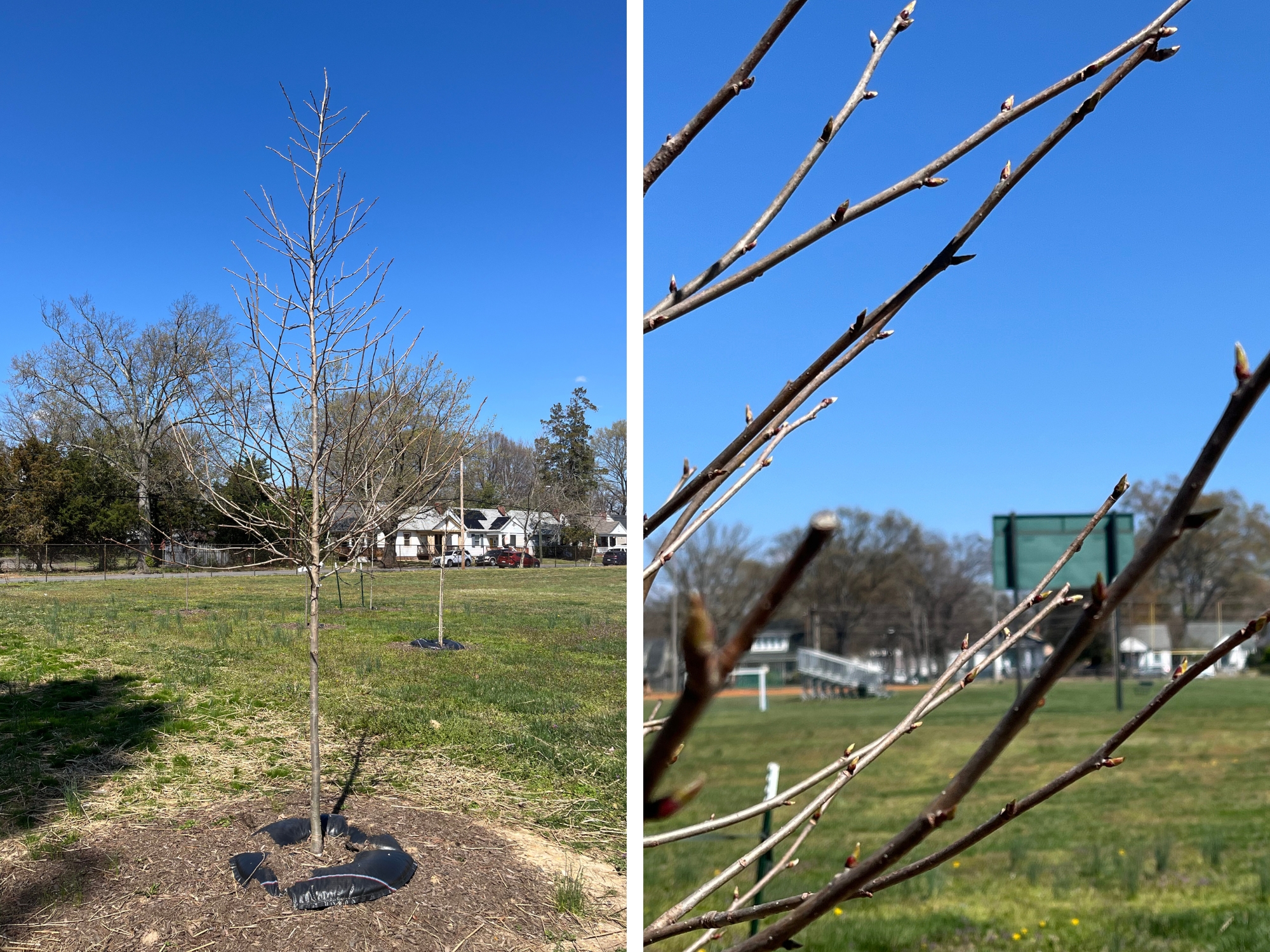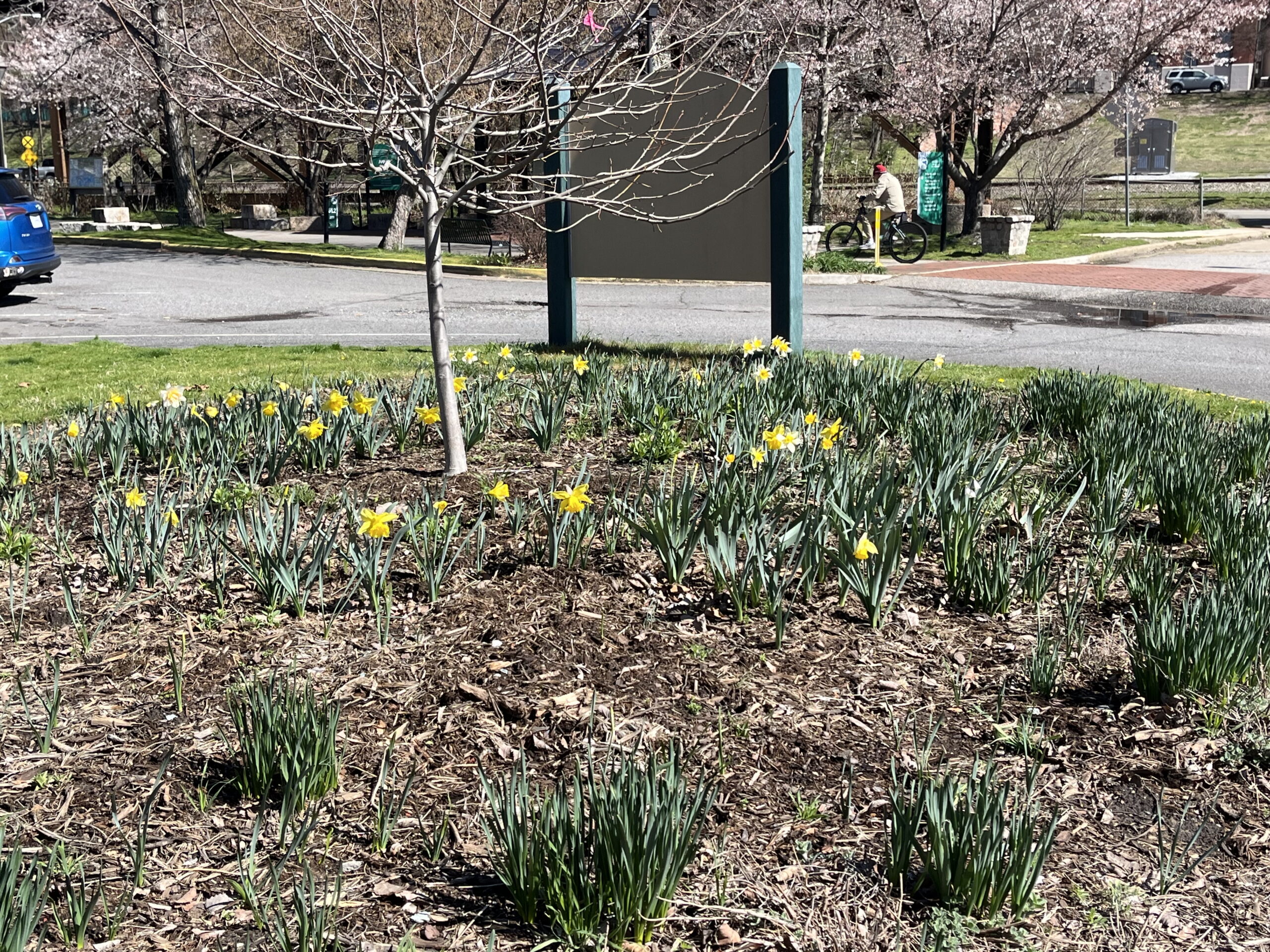March — The Fundamentals of Public Greenspaces
Cultivating Community: Prioritizing Engagement in Public Greenspace Design and Care
Did you know that people with greater access to greenspaces are 44% less likely to be diagnosed with an anxiety disorder? Reports from the National Recreation and Park Association also suggest that physical activity in greenspaces has stronger mental health benefits than physical activity in non-greenspaces (1). These statistics highlight how essential greenspaces are for both physical and mental well-being. Capital Trees believes that meaningful and equitable community engagement is not just a best practice but a fundamental requirement for creating parks that are vital, thriving spaces that serve the needs of the community. We understand that the success of a park isn’t just in its design—it’s in the community’s relationship with that space. Our commitment to community engagement strives to create public spaces that not only meet the environmental needs of the area but also become welcoming spaces that reflect the desires and values of the communities they serve.

The Power of Ownership: Why Community Engagement Matters
When individuals can see themselves in a space they feel a deep connection to that environment. Actively involving the community in the design process does more than just ensure that the space meets their needs—it empowers individuals. The impact of community-driven design is clear: it leads to increased park usage, reduced vandalism, enhanced social cohesion, and a sense of ownership. When individuals see the results of their collective input, they take pride in the space and are more likely to take on the role of stewards, ensuring that the space remains a valuable resource for future generations. However, it’s essential to acknowledge that not all communities have equal access to quality greenspaces. Truly listening to these groups—rather than simply consulting them—builds trust. Their lived experiences should guide the design decisions, and it’s essential to create spaces where their input is not only heard but also visibly incorporated into the final design.
Hotchkiss Green: A Multigenerational Gem
What was once an empty plot of turfgrass has been transformed into an active urban greenspace of walking trails, shade trees, gardens, and gathering spaces. Hotchkiss Green, developed by Capital Trees, is the newest addition to Hotchkiss Field Community Center, located in Richmond’s northside on Brookland Park Blvd. Built in the 1960’s, Hotchkiss Field Community Center is known for being vibrant, well-utilized, nostalgic for many, and a living example of the power of community space and the ways it can strengthen both health and connection. Community engagement is more important than ever when working in cornerstone spaces like these.
How can we redevelop and add to a public space without inhibiting the great contributions it already offers? We listen. Capital Trees held various virtual and in-person community meetings before, during and after (currently!) project development. We attend pop-up events and civic association meetings (ex. Highland Park Quality of Life) and shared online surveys so that those who can’t attend can still be heard. We continually offer informational sessions and tours where folks can not only learn more about the project but also share feedback. Through this engagement we had the privilege of hearing beautiful stories of childhood memories and life-changing experiences from those close to Hotchkiss and knew we couldn’t do this project without a partnership with local residents. Their stories and feedback directly inspired a space that now includes walking paths, shade trees, gathering space, and gardens for native and edible plants. We prioritized safety concerns such as sightlines, and additional entrances to the park for accessibility. We even partnered with community garden users to ensure we didn’t inhibit the important work they’ve been doing long before we arrived!
Capital Trees is committed to sustainable management practices, that includes maintaining and deepening these connections with the community long-term. Through our Community Volunteer Workdays and social events (Earth Day celebration at Hotchkiss 4/27!) we strive to not only support the ecological sustainability of the spaces we create but also the community cohesion that brings the space to life.

Best Practices for Meaningful and Equitable Engagement: Key Questions
When designing parks and public spaces, it’s crucial to engage with the community in a way that is both meaningful and equitable. An article from the American Planning Association suggests asking three fundamental questions—Who is Harmed, Who is Helped, and Who is Missing? (2).
Who is helped?— emphasizes engaging communities to help address systemic inequities, provide equal access to recreational resources and serve as spaces for cultural expression, healing, and collective action. In underserved communities, where access to greenspaces may be limited, such parks can become vital tools in reducing health disparities. By prioritizing the needs of all groups, parks can become tools for social justice, equity, and well-being.
Who is harmed?—calls attention to how a lack of inclusive engagement perpetuates existing inequalities by neglecting the voices of those who are already marginalized or underrepresented. It is essential to consider if/how a project can potentially cause financial, physical, cultural, and psychological harm. We have to explore how land-use decisions impact local residents and might prevent those populations from enjoying the broader benefits of greenspaces. Equitable planning requires a holistic perspective on community resilience that prioritizes ecology, public health, economic development, and civic involvement. Without considering the interconnectedness of these elements, and marginalized communities, inequities can be perpetuated.
Who is missing?—is a call to go beyond the “usual suspects” and actively seek typically underrepresented voices. Design choices that ignore people with disabilities can leave them with little to no access to parks. If the park doesn’t reflect the cultural identity of a community, it can become a space that feels alienating, rather than inclusive. Parks might be designed in ways that do not consider safety concerns for vulnerable populations, such as women, LGBTQ+ individuals, or seniors. Implementing strategies like multilingual materials, childcare during meetings, flexible meeting times, and partnering with trusted community leaders can help make participation more accessible.

The Ripple Effect: Health, Happiness, and Equity
When people are involved in the creation and stewardship of parks, the ripple effects extend far beyond the park itself. Accessible greenspaces are known to improve cardiovascular health, reduce obesity rates, prevent chronic diseases, reduce stress, and improve mood. Parks serve as communal hubs where people from all walks of life can meet, socialize, and build relationships. When people feel a sense of ownership, they are more likely to champion eco-friendly practices, volunteer, and ensure that the park remains a valuable resource for future generations. Investing in community engagement is not just about creating a park; it’s about fostering a long-term connection between the community and its greenspace.
Equitable access to quality parks is especially important for vulnerable populations. Designing parks that are accessible to people with disabilities, that consider cultural needs, and are located in underserved areas helps reduce health disparities. When everyone, especially vulnerable populations, has access to high-quality, inclusive greenspaces, the community as a whole thrives. Investing in community engagement is not just about creating parks; it’s about building healthier, happier, and more equitable communities for the future.
The Power of Community Engagement in Park Design and Care
Engaged communities are more likely to take responsibility for maintaining these spaces, making them safer, more welcoming, and better cared for over the long term. Parks created with local residents reflect the diverse needs and values of the people they serve, making them assets for physical health, mental well-being, and social cohesion. As you think about park design in your community, reflect on whose voices are traditionally left out of the planning process and how exclusion can perpetuate existing inequalities. Access to greenspaces shouldn’t be a privilege—it should be a right, and it’s up to all of us to ensure that every neighborhood has the opportunity to enjoy the benefits of high-quality, accessible parks. Capital Trees’ projects emphasize community involvement and sustainable practices, creating greenspaces that promote environmental stewardship and health equity. Your involvement—whether through advocating, volunteering, or simply raising your voice—contributes to the development of parks that not only serve current generations but ensure that future generations inherit spaces that are inclusive and sustainable.
Get involved and informed by following Richmond Inspire, Richmond’s latest parks and recreation plan, the work of Capital Trees and joining us for an Earth Day Celebration at Hotchkiss Green Sunday 4/27!!!

Works Cited
- National Recreation and Park Association. “Parks and Improved Mental Health and Quality of Life | Fact Sheets | Parks and Health | National Recreation and Park Association.” Nrpa.org, 2015, www.nrpa.org/our-work/Three-Pillars/health-and-well-being/ParksandHealth/fact-sheets/parks-improved-mental-health-quality-life/.
- Ezell, Kyle. “Three Essential Questions for Better Planning.” American Planning Association, Feb. 2022, www.planning.org/publications/document/9228741/. Accessed 1 Apr. 2025.
March — Urban Greenspace Maintenance
March is such a fickle month. A roller coaster of temperatures and weather that both tempt us with thoughts of balmy spring days and remind us of the cold, dark days of winter. But if you take a minute to stop, look, and listen you will realize that nature in all forms is waking up and preparing for another season. Spring ephemerals (bluebells (Mertensia virginica), Spring Beauties (Claytonia virginica), Bloodroot (Sanguinaria canadensis)), are emerging and beginning to show off their delicate fleeting blooms. The scent of Daphne perfumes the air.
In Great Shiplock Park, the Hellebore blossoms dance in the cool breeze and the daffodils (generously donated two years ago by Siteone on Old Staple Mill Road) abound delighting the viewer with their cheery yellow and white trumpets. Along the Low Line, the fat buds on the Packera are about to burst open.

Our feathered friends are seeking out mates and the perfect location for their spring nest. At the Low Line Gardens, the mockingbirds can be seen guarding the last of the winterberries (Ilex verticillata) which were once bright red but are now slowly drying to look more like raisins. A pair of geese and mallards can be seen on the Kanawha Canal searching out the perfect location to raise the next brood.

In the Low Line Gardens, activity abounds. The foliage on the elderberry (Sambucus canadensis) is slowly emerging. The buds are swelling on the redbuds, Fothergilla, and deciduous Azaleas. The purple blooms of the woodland phlox (Phlox divaricata) beginning to dot the gardens. Under the dead stems of last season’s growth, the new growth of the Solidago, Asters, Phlox and Rudbeckia has begun poking through.

The first Community Workday of the season occurred on Saturday, March 15th. Over 35 people gathered at the Low Line Gardens. Together they worked tirelessly to prepare the garden for spring.
Spring maintenance tasks included:
- Pruning the Viburnum dentatum, elderberry (Sambucus occidentalis), and Itea. These plants are pruned annually to control size, and we remove older canes to promote healthy new growth and improve air flow.
- Cutting back old foliage on Amsonia and asters (Symphyotrichum). The old foliage provides winter interest, habitat for insects, and protects the crowns of the plants from winter cold and moisture. Ideally, home gardeners should hold off on a full clean up until temperatures are consistently above 50 degrees. To get ahead on weed control, and to ensure the gardens remain well kept, this time of year we go ahead and cut back old growth to allow for new growth this season. We leave debris onsite so that any overwintering insects are able to complete their lifecycle.
- Cutting back grasses and joe pye weed (Eupatotium) in the rain garden. The rain garden has earned its keep the last few weeks — it’s designed to catch the run off from gully washer rains like we have experienced recently and filter the water before it eventually reaches the canal.

Before and afters of progress made during the workday.

We’d also like to give a big shout out to our weekly volunteers. Gardening at the Low Line continues year round on Wednesday mornings, weather permitting. A dedicated group of “regulars” and guests ensure that the gardens are visitor ready, no matter the season.
One of our longtime volunteers, Jerry Gilbert, has generously donated his time to erecting and maintaining a mason bee box at Great Shiplock Park. Mason bees are one of the earliest bees to begin work in the spring. Though they have a relatively short adult life span they pollinate up to 95% of the flowers they visit, making them incredible to have in our gardens.

In late fall, Jerry removes the cocoons and keeps them in the refrigerator through winter. This helps ensure the cocoons survive the winter months, protecting them from ants. In mid-spring when the weather warms, the cocoons are returned to the nesting box to pupate.
Once the lifecycle of the adult mason bees has finished for the season, the cocoons of a close relative, the leafcutter bee, are then placed in the nesting box. The leafcutter bees pick up where the mason bees left off by pollinating various plants. These bees can have multiple life cycles in one season enabling their work to continue into the summer months.
Transitioning from the Low Line Gardens to Hotchkiss Green, Capital Trees’ in-progress project. In the next few weeks we will be adding perennials and grasses to the tree and shrub plantings that have already been installed. We invite you to visit and enjoy walking the new permeable asphalt trail while admiring the beauty of the flush of new spring growth on the trees and shrubs.
Whether you visit one of our projects or another greenspace near where you live or work, we invite you to venture out and enjoy all that nature offers this spring.
March— Featured Trees Seasonal Update

We checked in on the black gum trees planted at Hotchkiss Green at the end of March. They still look dormant from a distance, but when you take a closer look you can see leaf buds beginning to swell and open.
Throughout 2025, we’ll be documenting the black gum tree, Nyssa sylvatica, which is planted at many of our urban greenspaces. This native tree is one of our favorites, hence its wide use. It offers interest every season of the year — shiny green leaves in the summer, brilliant reds, yellows, oranges and purples in the fall, and architectural structure in the winter.
Important for our purposes, black gum trees thrive in a variety of growing conditions making it suitable for planting in urban soils. They are tolerant of drought, heat, and both dry and wet soils. Typically, in cultivated conditions, the tree matures at 20-30 feet in height with a 1-2 inch diameter trunk. Because it’s native, it supports a variety of wildlife including mammals, birds, and insects.
You can learn more about black gum trees here.
March — “Spotted At” the Great Shiplock Park

Over the past two years, the Virginia Daffodil Society has installed 1200 historic daffodil bulbs at Great Shiplock Park. The historic cultivars, Ornatus, Emperor, Empress, Sir Watkins, and Conspicuus, were registered between 1850-1880 when the lock system was active in Richmond. We’re so excited to “spot” the blooms already appearing this spring, and they’ll continue to bloom for many years, paying homage to the area’s past. Thank you to the volunteers who have spent time the past two fall season planting bulbs, and to the VDS for the donation.






 Join us for an outdoor Earth Day Celebration!
Join us for an outdoor Earth Day Celebration!







